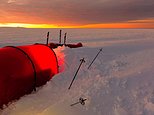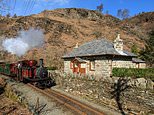
Shards of aquamarine ice pierced the ominous grey landscape as we trundled along in our giant truck, with strong gusts of snow-peppered wind battering us as we went.
I have to admit that I wasn’t terribly looking forward to the prospect of pitching a tent amid this apocalyptic landscape.
We were making our way towards the snowfields of Europe’s largest glacier (by volume), which is located on the east coast of Iceland, as part of a week-long training exercise in preparation for an upcoming North Pole expedition centred around climate change.
Sadie said there wasn’t much the team could do while sat in the tents, other than talk and eat
Sadie (far right) pictured in her tent during the storm with expedition leader MBE Felicity Aston (far left) and fellow teammate Emma Ranger
Sadie and her teammates were stuck in a storm for three nights on Europe’s largest glacier
Vatnajokull, the glacier in question, covers an impressive 7,900 square kilometres (3,050 square miles), has starred in two James Bond films – A View to a Kill and Die Another Day – and is known for its unforgiving weather, especially during the winter months.
We ventured to the frozen wasteland at the end of October in 2021 and on getting to its icy fringes in special monster truck-like vehicles we witnessed its unforgiving beauty.
‘It looks like we’re on another planet,’ one of our team members said while rolling down the window and swiftly doing it up again in a bid to avoid the biting cold.
The Vatnajokull glacier is known for its unforgiving weather during the winter months
To get to the glacier, Sadie and her team travelled in special trucks that could navigate the frozen landscape
Calm before the storm: A shot of the expedition tents on the glacier just before the storm hit
The camping teams used expedition stoves to heat snow for water and to keep warm
There are six of us taking part in the all-female North Pole expedition, which was put together by MBE Felicity Aston during the pandemic and is due to get underway this April.
Our goal is to conduct crucial research around Arctic sea ice to understand more about its deterioration due to climate change.
As British-born Felicity now lives in Iceland, on a remote island called Vigur, and knows the lay of the land, we decided to do our training there.
Before leaving for the glacier, we had spent time in Reykjavik preparing our sledges with the necessary gear, which included tents, sleeping bags, freeze-dried meals, sweet treats, some spare clothing and shovels to dig snow and toilet pits.
We also hired skis and made sure our ski boots fitted as our expedition involves cross-country skiing, which Felicity describes as being something anyone can do and ‘just like skating across a polished floor in socks’.
After a couple of hours of driving, the trucks stopped on a particularly snowy swathe of land and dropped us off. This is where we would start our training and pitch our tents for the night.
The team had to venture out every two hours to get rid of excess snow from the tents
The tents were secured in place with skis and ski poles, which makes it easier to dismantle in the snow
Vatnajokull covers an impressive 7,900 square kilometres (3,050 square miles)
One of the team members digs out their sledge from the snow (left), while Felicity Aston enjoys a spot of sunshine amid the snowy landscape (right)
Thankfully, when we got out of the trucks the sun was out and the wind had died down. It was actually pretty pleasant.
The six of us went about pitching our two tents after a practice run in a car park earlier that morning. The tents went up fairly smoothly and we fixed them into the snow using our skis and ski poles.
After we bid the truck drivers goodbye along with some film crew who had been following us and our lead scientist, Dr Ulyana Horodyskyj, we settled into our tents to rustle up some boil-in-the-bag chili con carne and nestle into our sleeping bags.
The all-female team conducted scientific studies while on the ice in preparation for their main expedition
The storm meant that the visibility was very poor on the glacier and it was only possible to see a few metres
It took more than two hours to dig the tents out of the snow (left), Sadie looking relieved after finally leaving the confines of her tent (right)
It wasn’t long before the situation rapidly started to change. The winds whipped up to a deafening pitch and battered the tent from every angle.
I unzipped the tent’s front door to have a peek outside and we saw that the snow was quickly gathering. If we didn’t act pronto we’d be buried alive.
Felicity braced the winds from her tent to come and tell us that we should do two-hour shifts to keep the snow at bay, so we geared up for a long night ahead.
A shot of Dr Ulyana Horodyskyj, the lead scientist on the B.I.G North Pole expedition
The views out of the tent after the storm had stopped, with clear skies and sunshine
After the winds stopped, the team could finally get on their way and practice some cross country skiing
Somehow, despite the constant battering and snow duties, I managed to get some sleep with the hope of some calm the next day. But the calm never came. The 80mph winds continued to roll with a haze of snow making it impossible to see further than a few metres.
The tents were well and truly fixed into position, submerged by a thick wodge of white powder. Being stuck in a tent in -20C temperatures doesn’t leave you with an awful lot to do.
The mornings consisted of waking up and using a squeegee to chip the ice from the inside of the tent before it started to melt.
Then we fired up two expedition stoves to help dry things out and melt some snow for hot water. A cup of tea definitely helped matters.
Being tent bound for three days, Sadie said, was definitely a bonding experience with tears and laughter along the way
After a cuppa and bowl of porridge, we bundled up in some warmer layers and goggles and ventured outside to try and get rid of excess snow.
On the toilet front, because it was so windy and snowy it was impossible to get to the pit we’d previously dug. I almost blew away when I tried.
This meant we resorted to digging a pit in the porch of our tent and using that for our ablutions.
During the day, we talked about life – we’d only met on Zoom up until training – checked in with the other tent, tried to get weather updates and gorged on our snack bags, which featured chunks of marzipan, popcorn, boiled sweets and chocolate raisins.
The B.I.G North Pole expedition is set to take place in April
Then at dinner time, the highlight would be seeing what meals we had for the evening. Derbyshire-based Basecamp Foods is one of our expedition sponsors and it serves up a surprisingly delicious spread of camping meals with high-calorie counts to power us on our way.
Sleeping through the night was a little tricky with the tent manically flapping around and an icy cold wafting around our heads, but having robust down feather sleeping bags from Rab definitely helped make things a little more comfortable.
After three nights it was quite an incredible moment when we awoke… to the sound of silence. It was like we’d been listening to death metal on repeat for days and my ears were still ringing.
I opened a flap near the cooking station and revelled in the sight of a clear blue sky and sunshine.
Before we set off to finally do what we’d gone to Vatnajokull to do – ski – we had the slight matter of taking down the tents to deal with.
It took more than two hours to dig the tents out with all of us pitching in to do rounds of shovelling. Eventually, we got on our way and set off towards the mountainous horizon with our sledges in tow.
Being tent-bound for three days was definitely a bonding experience with tears and laughter along the way.
Felicity, who has more than 20 years of experience exploring polar landscapes, said following our ordeal: ‘I’m really proud of you guys. Most of the locals expected us to radio in for help to evacuate but we stuck it out. I promise it won’t be this windy at the North Pole.’
Fingers crossed!
For more information on Sadie’s B.I.G North Pole expedition and to track the team’s progress visit: www.bignorthpole.com.
TRAVEL FACTS
PLAY is an Icelandic low-cost airline that offers flights from Stansted to Iceland Reykjavik four times a week from £30 one way, inclusive of taxes.
For additional information and bookings please visit flyplay.com
Source link
CHECK OUT: Top Travel Destinations
READ MORE: Travel News



